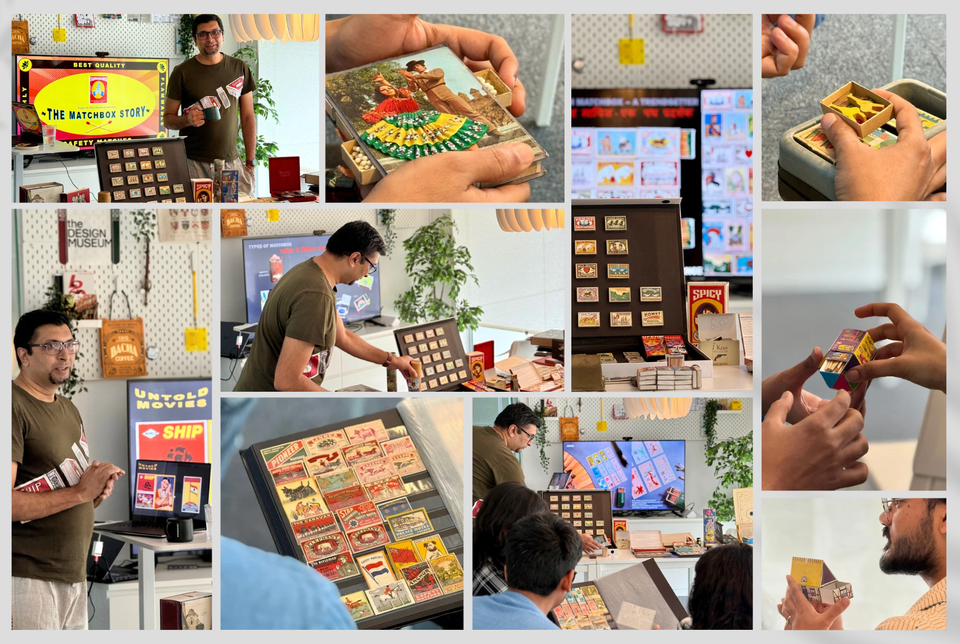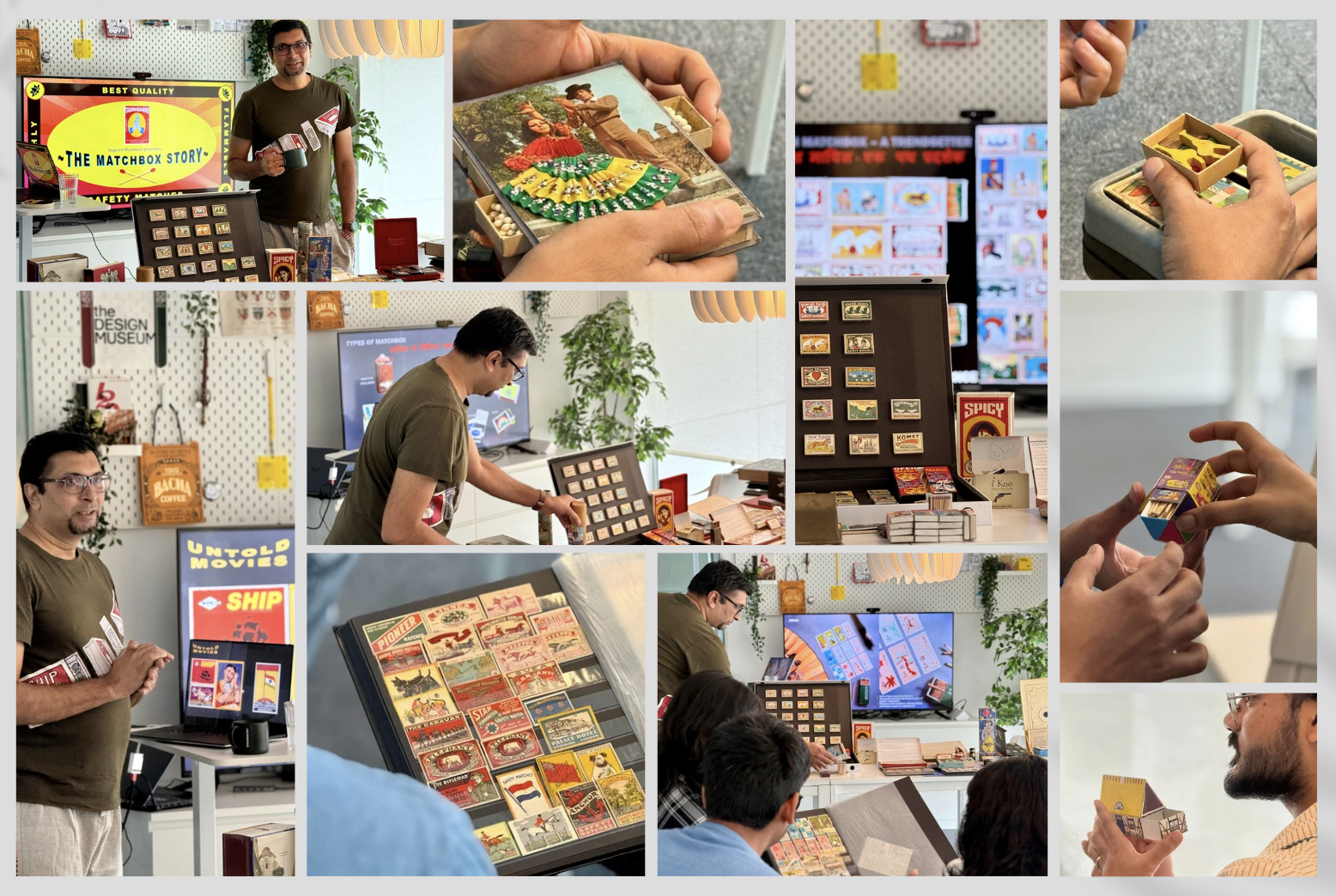Tiny Boxes, Mighty Stories

Notes from “The Matchbox Story” with Yogesh Maralkar at Wolffkraft Design Studio as part of The Extended Pack Collective.
Today, the Extended Pack Collective came together at the Wolffkraft studio in Bengaluru for a session that lit up our curiosity, quite literally. Yogesh Maralkar, Lead Designer at Tata Elxsi and proud keeper of a 20,000-strong matchbox collection, took us on a deep dive into the world of matchboxes. In just two hours, he demonstrated how this everyday item became a powerful storytelling tool—utilised for art, culture, advertising, and even propaganda, all within a tiny, throwaway box.
A Short History of a Small Flame
1830s
Friction matches, nicknamed “Lucifers,” light up Europe. But their unpredictability leads to accidents—pockets and entire factories go up in flames.
1850s
Safety matches change everything. The chemical reaction is split: phosphorus is moved to the striking strip, and the risk of accidental ignition drops drastically.
Early 1900s
India’s match industry takes root in Calcutta and Sivakasi, importing Swedish manufacturing techniques and borrowing visual styles from Japanese print culture.
Today
India leads the world in matchbox production and export, even as most countries move toward lighters and digital ignition.
Yogesh beautifully placed this evolution alongside other industrial milestones, such as the introduction of currency notes (first printed in India in 1861) and postage stamps (introduced in 1840). His point? Matchboxes predate many of the “permanent” icons we take for granted.
What we dismiss as disposable was once a symbol of modernity, global trade, and even national identity.
Pop-Art Powerhouse
Long before digital ads and billboard takeovers, matchboxes quietly carried stories, symbols, and even propaganda into the farthest corners of the country. In a time when access to mass media was limited, these tiny boxes became unlikely messengers. You could spot them tucked inside kitchen drawers, by the roadside in tea stalls, or on the dashboards of long-haul trucks. And though unbranded, their visuals were striking—roaring tigers, powerful locomotives, mythological figures, and even Bollywood stars. With just two square inches of printed paper, brands can achieve remarkable reach at a cost of just a few paise.
During India’s struggle for independence, matchboxes also played a quiet role in resistance. When press freedom was curtailed and censorship was widespread, these small labels became vehicles for national sentiment. Images of Gandhi, Subhas Chandra Bose, and other freedom fighters made their way into homes, not through newspapers, but via matchboxes that slipped under the radar of colonial scrutiny.
This visual culture had deep artistic roots. The legacy of Raja Ravi Varma, whose paintings blended Indian subjects with European techniques, found new life in the rise of chromolithography. As the printing technique spread, devotional prints became widely accessible and soon spilt over onto matchbox covers. From those early litho prints grew an aesthetic that would define Indian packaging for decades. Even today, echoes of this style can be seen in chai stall murals and product labels—bold, colourful, layered with symbolism, and instantly familiar.
Matchboxes, it turns out, weren’t just tools for lighting fires. They were quiet carriers of imagination, identity, and influence.

Anatomy of a Collector
Yogesh’s journey into the world of matchboxes began in the most relatable of places: school corridors. As a child, he would trade matchbox labels with classmates using bits of pocket money, unknowingly sowing the seeds of a lifelong fascination. Like many childhood hobbies, the collection paused during the intense academic years at IIT. But after stepping into the world of design, his trained eye reawakened to the beauty hidden in those tiny, disposable canvases.
Today, Yogesh doesn’t just collect matchboxes; he curates them with intention and a designer’s sensibility. He organises his vast archive through three lenses.
- Narrative – Does the label tell a micro-story (e.g., “The Great Banyan”, 1952)?
- Craft – Letterpress mis-registrations, wood-pulp textures, hand-carved blocks.
- Context – Political events, export tags (“For USSR Only”), materials (wood, card, even tin).
The biggest takeaway for fellow designers is that collecting isn’t just about possession. It trains the eye to notice variations, patterns, and stories that unfold over time. It teaches you to see design not as isolated moments but as evolving iterations, each a small step in a much larger narrative.
A Global Gallery in Palm-Sized Boxes
One of the most fascinating insights from Yogesh’s session was how matchboxes, despite their fixed size and function, become miniature mirrors of the cultures from which they originate. They may share the exact shape of a simple, rectangular box, but across borders, they tell entirely different stories.
In Sweden, for instance, matchboxes often feature minimalist illustrations of native wildlife, such as moose, owls, and pine trees, many of which are remnants of government-led forestry campaigns. Clean lines and earthy tones reflect the country’s deep respect for nature and its Scandinavian design ethos.
In Russia, matchboxes became collectable items in their own right. The entire series was printed on birch veneer, commemorating national pride, space milestones like Sputnik, great chess grandmasters, and Olympic venues. These were not just boxes; they were patriotic artefacts made with durability and reverence.
Japan brought an entirely different flavour. Matchboxes often featured delicate, ukiyo-e–inspired imagery, with lanterns glowing softly and cats lounging in poetic poses, printed on smooth, satin-finish paper. Even in the most minor details, Japanese visual culture found ways to elevate the ordinary.
In India, ITC’s “Little Schoolmaster” series stands out: a set of matchbox labels that doubled as learning tools. Each box carried fun science facts, turning a simple object into a STEM flashcard, cleverly blending education with everyday function.
What these examples show is the same thing designers often discover: constraints spark creativity. A fixed die line and the unchangeable template of the matchbox became a playground for cultural expression. Each country found ways to pour its character, values, and visual language into that tiny space, turning matchboxes into a global gallery of design in the palm of your hand.
Why Matchboxes Still Matter
Despite being over 170 years old, the basic design of a matchbox has remained essentially unchanged and remains a classic piece. The user experience is simple and universal: slide open the box, strike the match, create a flame, and close it. This flow is so intuitive that it rarely needs instructions. It is a perfect example of good design, where the form naturally guides the function.
Matchboxes also raise important questions about sustainability. On one hand, wooden matchsticks are single-use and disposable. On the other hand, lighters may last longer. Still, they introduce plastic waste and harmful chemicals, such as butane, into the environment. So, which is the better option? There is no clear answer yet, and both sides of the debate continue to raise valid points.
Beyond function and sustainability, matchboxes also remind us of the power of simple storytelling. In a world flooded with high-resolution screens and endless scrolls, a matchbox has only 37 by 50 millimetres of space to get your attention. That tiny area has to be clever, sharp, and clear. It teaches us that strong ideas don’t need big canvases. Sometimes, the smallest canvas can carry the most prominent voice.
Key Takeaways for Designers
Matchboxes teach us that scale depends on mindset, not on canvas size. Even a tiny object like a matchbox can hold big stories. It can reflect a culture, celebrate a national figure, or teach science. Designers often work with large formats, but matchboxes show that strong ideas can fit into the smallest spaces when the intention is clear.
They also remind us that ephemera can last. What feels disposable today might become a cultural artefact tomorrow. People once ignored or threw away matchboxes. Now, collectors and designers study them to gain insight into history and design trends.
As designers, we should pay attention to the everyday details, as they carry long-term meaning. Collecting also sharpens a designer’s perspective. When you track design across time, you start noticing patterns, shifts, and small details. Yogesh built his collection over the years, and it taught him to see how design evolves. This habit strengthens pattern recognition, which is crucial when mapping out product journeys or forecasting design directions.
Matchboxes also prove that constraints can spark creativity. Designers worked with just two colours, rough paper, and a fixed frame. Instead of limiting them, these rules pushed them to make smarter, clearer, and more memorable visuals. For modern designers working within guidelines, matchboxes offer a clear lesson: restrictions often lead to the most charming and effective work.
Yogesh didn’t just speak about matchboxes—he wore his passion quite literally. Dressed in a t-shirt printed with vintage labels and a vibrant jacket covered in matchbox art, he arrived as a living extension of his collection. His energy was contagious. It quietly urged the next generation to step away from their screens and look back at history, forgotten objects, and the evolution of everyday design. In a world obsessed with the new, he reminded us of the timeless beauty that can be found in the old.
The session reminded us that design does not always need to create something new. Sometimes, its true power lies in helping us see the everyday with fresh eyes. Yogesh Maralkar did precisely that. Through the soft glow of a single match, he revealed how even a small, throw-away object like a matchbox can hold deep meaning.
He showed how it connects craft, commerce, and culture in powerful ways. One simple strike can ignite not just a flame but a whole world of stories.
Member discussion